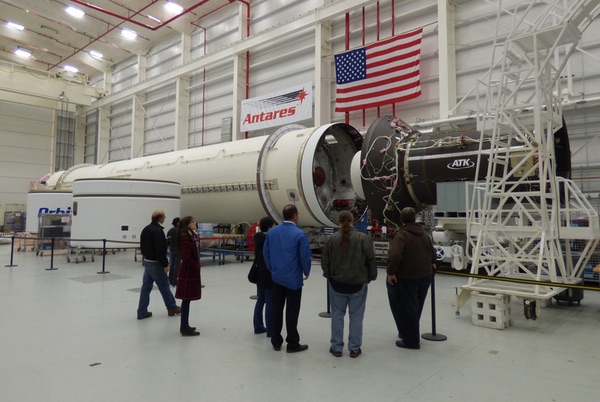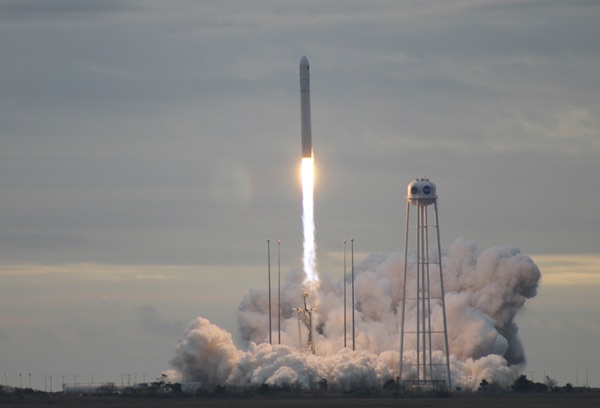A tale of two rocketsby Jeff Foust
|
| “For everyone that’s listening, we’d just like to encourage everyone to just listen to the range authorities, pay attention to the notice to airmen, the notice to mariners, that they put out weeks in advance of each launch,” said Eberly. |
Then came that five-letter word that, for the mission teams as well as those in attendance, had the effect of a four-letter one: “Abort!” A small plane had entered restricted airspace, flying at about 150 meters altitude ten kilometers offshore, not responding to radio instructions to change course. (A social media flash mob had initially blamed it on a commercial airline flight, based on flight tracking data, but that airliner was outside of restricted airspace.) With only a five-minute window, the launch was scrubbed for the day.
A day later, things worked out better, but not without some tension. Controllers moved the launch from the beginning to the end of a five-minute window primarily to address an issue with the chilling of one of the rocket’s two RD-181 main engines. That delay, though, also gave the range more time to deal with two boats in danger of going into restricted waters. The boats stayed away, though, and the Antares successfully lifted off.
There was a little bit of frustration evident in an otherwise celebratory post-launch press conference because of Saturday’s scrub and the near-miss Sunday. “For everyone that’s listening, we’d just like to encourage everyone to just listen to the range authorities, pay attention to the notice to airmen, the notice to mariners, that they put out weeks in advance of each launch,” said Kurt Eberly, deputy program manager for Antares at Orbital ATK. “We ask for everyone’s cooperation to just follow the direction of the range crew and troopers that keep everybody safe and out of the hazard area.”
Antares launches are relatively infrequent from Wallops. It had been more than a year since the last Antares launch, in October 2016, which was the return to flight of the rocket after a failure seconds after liftoff nearly two years earlier. Orbital, after the 2014 accident, bought two Atlas V launches from United Launch Alliance to ensure it could continue Cygnus missions to the ISS under its Commercial Resupply Services (CRS) contract with NASA.
After last October’s launch, where the Antares successfully sent a Cygnus to the station, it appeared the vehicle was back on track. Weeks later, though, Orbital ATK announced it would launch its next Cygnus on another Atlas V. The company cited a desire by NASA for additional cargo—a Cygnus launched on an Atlas V can carry more than one launched on an Antares—as a reason for the contract.
| “Our baseline plan is to continue to fly Cygnus on Antares,” DeMauro said. |
The company, though, says it’s back to using its own Antares rocket for the foreseeable future. Frank DeMauro, vice president and general manager of Orbital ATK’s Advanced Programs Division, said at a pre-launch press conference that the remaining three missions under its existing CRS contract, named OA-9, 10, and 11, as well as at least the first two missions under its follow-on CRS-2 contract—named, logically enough, OA-12 and 13—would all launch on Antares.
“Our baseline plan is to continue to fly Cygnus on Antares,” he said. “We are ready to respond to our customer’s needs, if they should require something different, but for all of the rest of CRS-1 and so far for the CRS-2 missions we’re planning to do them on Antares.”
Those launches remain, for now, the only ones on the Antares manifest. Other than its inaugural launch in 2013, carrying a demonstration payload, every Antares launch has carried a Cygnus spacecraft, either for its Commercial Orbital Transportation Services (COTS) award or ongoing CRS contract.
Orbital ATK says it’s been looking for other customers for Antares, which had its origins before the COTS program as the Taurus II, a vehicle intended to be a replacement for the Delta II. Eberly said the company is in discussions with NASA and commercial customers for Antares launches, but at the pre-launch press conference declined to discuss specifics.
“We are interacting with the civil government and commercial markets, and we are offering Antares,” he said.
That stands in contrast with the other company that completed a COTS award from NASA. In between Saturday’s scrub and Sunday’s launch, SpaceX carried out a static-fire test of a Falcon 9 for its next mission, carrying a classified payload known only a “Zuma.” That launch, scheduled for Wednesday evening, will be the 17th Falcon 9 launch of the year. Sunday’s Antares launch was the seventh in the vehicle’s entire history, including the 2014 launch failure.
So why is Falcon 9 doing well in the market while Antares is struggling? One possibility is the cost. Orbital ATK has not disclosed costs of Antares launches, but it’s widely assumed in the industry that an Antares costs more than a Falcon 9.
A paper published recently by Edgar Zapata, a life cycle analyst at the Kennedy Space Center, examined the economics of commercial cargo and crew programs. It found that, for Cygnus missions to the ISS, NASA was paying $135,000 per kilogram of delivered cargo, about 50 percent more than Falcon 9/Dragon missions under the CRS program. NASA, at least, was willing to pay more for those Cygnus missions, be they launched on an Antares or an Atlas. (That higher price is still about half the cost per kilogram of cargo delivered to the station on shuttle missions using a Multi-Purpose Logistics Module.)
It’s not for a lack of investment. That same paper noted that, in addition to the $412 million (in 2017 dollars) NASA provided under the COTS program, Orbital ATK invested $691 million of its own money, while the Commonwealth of Virginia provided $90 million for the launch site at Wallops, for a total cost of nearly $1.2 billion. The paper splits that evenly between Antares and Cygnus, although the actual cost split isn’t known.
SpaceX, meanwhile, invested $545 million into Falcon 9 and Dragon development, in addition to the $475 million in COTS funding (again in 2017 dollars.) There, the cost split is known: the paper estimates $360 million went towards Falcon 9 while $660 million to Dragon.
 The Antares rocket for the next mission to the ISS, planned for launch as soon as the first quarter of 2018, sits in a hangar at Wallops undergoing testing. (credit: J. Foust) |
Another issue is the market itself. Orbital ATK (and its predecessor, Orbital Sciences) saw Antares as a replacement for the aging Delta II, which a decade ago was doing a brisk business for NASA and the Air Force, as well as some commercial customers. But demand for the medium-class Delta II has diminished in recent years: the Air Force moved its payloads to the Atlas V and Delta IV, leaving only NASA payloads.
The penultimate Delta II launch is scheduled for early Tuesday, carrying the first Joint Polar Satellite System (JPSS) weather satellite; the last Delta II launch, planned for no earlier than September 2018, will launch ICESat-2. NASA payloads that once would have flown on Delta II are now flying on the Atlas V or, more recently, the Falcon 9.
| “We continue to invest in the Cygnus spacecraft and the Antares rocket to be able to provide more to our customer,” DeMauro said |
Changes in the commercial market also hurt Antares. Most interest for commercial launches are either for very large satellites, too heavy for Antares, or for small satellites, or constellations of them, which again don’t fall into the sweet spot of Antares. The current Antares launch site in Virginia is not optimal either for geostationary satellites, given its distance from the Equator, or for polar-orbiting satellites because of range issues. (Antares could launch polar-orbiting satellites by flying east and then doing a dogleg maneuver, but at a significant loss of payload performance.)
Orbital ATK is looking ahead, if not beyond Antares, to at least a larger launch vehicle. The company earlier this year unveiled plans for what it simply calls Next Generation Launch (NGL), a vehicle it proposes to launch EELV-class payloads handled today by United Launch Alliance and SpaceX.
Last week, it announced a milestone in work on NGL—testing of a case for the solid-propellant motors that will be used on NGL’s lower stages—while finalizing a proposal to the Air Force due later this month for a program called Launch Services Agreements to fund development of vehicles as part of a larger effort to end reliance on the Russian-built RD-180 used on the Atlas V. The Air Force is expected to make several awards under that program next year, and later pick two companies for contracts for launching national security payloads.
For now, Antares will continue flying for the next several years at a rate of a couple missions a year, at least to carry out the company’s CRS contracts. Both Orbital ATK and NASA appear satisfied with Antares and Cygnus. At the post-launch press conference, Eberly said there was an “over-performance” of the rocket compared to its models, similar to what they saw on the previous Antares flight. While he said engineers were being conservative in those models, that additional performance might enable slightly heavier payloads to fly on future missions.
“We’re going to be adjusting our models, and when we do that, we’ll be able to bank a little bit more margin,” he said, which could be used for Cygnus based on internal discussions and those with NASA.
“We continue to invest in the Cygnus spacecraft and the Antares rocket to be able to provide more to our customer,” DeMauro said prior to the launch.
The next Antares rocket is already at Wallops, undergoing tests in a horizontal integration facility several kilometers from the launch pad. That rocket and its Cygnus spacecraft could be ready for launch on the OA-9 mission as soon as the first quarter of 2018, DeMauro said, depending on NASA’s needs.
It might be later than that, though. As a bus returned media from the viewing site Sunday morning after the launch, the bus driver said, “See you in May!” In any case, given the issues with this weekend’s launch, it’s worth considering posting advisories for that upcoming mission for pilots and boaters now.
